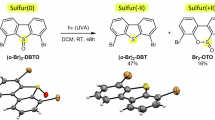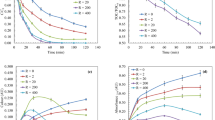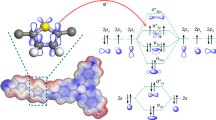Abstract
IN a recent note under the above title1, Prof. J. W. Cook described a number of water-insoluble peroxidic photo-oxides derived from carcinogenic hydrocarbons. Experiments made in Cambridge during the past year indicate that a photochemical oxidation product, which is different in character both from those prepared by Cook and from the alkali-soluble materials prepared by Boy land, can be obtained from 3: 4-benzpyrene under suitable conditions. 10 c.c. of a 0·1 per cent solution of the hydrocarbon in benzene (B.D.H., 'Specially Pure') is irradiated for one hour in an open Petri dish placed three inches below a neon-sensitized mercury lamp of the type described by Melville2, nearly all the energy radiated from which is concentrated in the 2536 A. resonance line. The remaining benzene is quickly evaporated off in a current of air, and the dry residue is extracted with 10 c.c. of glass-distilled water or with weak alkali (M./500 NaHCO3) and filtered. The resulting solution is colourless—unlike the solid residue—and its absorption spectrum, I, contains two very well-defined bands, with maxima of intensity at about 3600 A. and 2760 A. respectively. When the aqueous solution is allowed to stand, the band at 3600 A. disappears, while that at 2760 A. becomes less intense, in the course of 3–4 hours, II. The spectrum is not of the dihydroanthracene type such as is that, for example, of the water-soluble endosuccinate derivative of 1: 2: 5: 6-dibenzanthracene. It indicates, however, that a labile water-soluble photo-oxidation product can be prepared from 3: 4-benzpyrene, even though this compound gives no photo-oxide of the peroxidic type. Schulman and Rideal3 have shown that the labile constituent of the aqueous solution can be adsorbed readily on to protein monolayers. These observations may be correlated and compared with the experiments on the photodynamic activity of the hydrocarbons described by Mottram4.
This is a preview of subscription content, access via your institution
Access options
Subscribe to this journal
Receive 51 print issues and online access
$199.00 per year
only $3.90 per issue
Buy this article
- Purchase on SpringerLink
- Instant access to full article PDF
Prices may be subject to local taxes which are calculated during checkout
Similar content being viewed by others
References
Cook, J. W., Martin, R., and Roe, E. M. F., NATURE, 143, 1020 (1939).
Melville, H. W., Trans. Farad. Soc., 32, 1525 (1936).
Schulman, J., and Rideal, E. K., NATURE, 144, 100 (1939).
Mottram, J. C., and Doniach, I., Lancet, 1156 (1938).
Lowry, T. M., and Allsopp, C. B., Proc. Roy. Soc., A, 133, 48 (1931)
Author information
Authors and Affiliations
Rights and permissions
About this article
Cite this article
ALLSOPP, C. Photo-Oxides of Carcinogenic Hydrocarbons. Nature 145, 303 (1940). https://doi.org/10.1038/145303a0
Issue date:
DOI: https://doi.org/10.1038/145303a0
This article is cited by
-
A Water-soluble Carcinogen Derived from 3: 4-Benzpyrene
Nature (1942)



